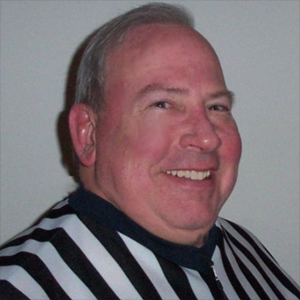
Rndballref
20 Years Experience
Chicago, IL
Male, 60
For twenty years I officiated high school, AAU and park district basketball games, retiring recently. For a few officiating is the focus of their occupation, while for most working as an umpire or basketball referee is an avocation. I started ref'ing to earn beer money during college, but it became a great way to stay connected to the best sports game in the universe. As a spinoff, I wrote a sports-thriller novel loosely based on my referee experiences titled, Advantage Disadvantage
Yes, it is a backcourt violation because team A never lost team control.
I obviously didn't see the play, but if the defender has obtained legal guarding position (that is, he is entitled to the space he is at) and the opponent crashes his face into the defender's knee it is either a no-call or an offensive player control foul.
It is a violation for a player to leave the floor for an unauthorized reason. The ball is dead when the player goes out of bounds and is awarded to the opposite team.
I do not have any special knowledge of AAU league or tournament rules. I do know that age verification is a perpetual problem in traveling basketball.
Basketball Referee
 Ever get into a physical altercation with a crazed parent?
Ever get into a physical altercation with a crazed parent?
Bracketologist
 Where do you think the Selection Committee needs the most improvement?
Where do you think the Selection Committee needs the most improvement?
Call Center Employee (Retail)
 When do your policies allow you to hang up on a rude caller?
When do your policies allow you to hang up on a rude caller?
If there are two violations by players in lane spaces the 2nd is ignored.
If the 2nd violation is from beyond the arc both are penalized and you go to the possession arrow.
While it is not ideal, a game can begin with 1 referee. It seems that it happens occasionally at the lower levels but rarely at the Varsity level because if the Varsity crew is short a ref, they will invite a ref from the pre-lim (usually sophomore) game to stay and work the game with them.
When I have had to ref myself, I find that play under the basket gets rough because the players know that you can only follow the ball. You also miss a lot of line calls.
On a spot throw-in, a player must stay within a 3 foot area along the out of bounds boundary. That three foot area extends from the out of bounds line all the way back to the wall, or the first obstruction (bleachers, table, etc.).
So to answer your question, as long as the player does not step in bounds before releasing the ball, he can take as many steps forward short of breaching the out bounds line.
-OR-
 Login with Facebook
Login with Facebook (max 20 characters - letters, numbers, and underscores only. Note that your username is private, and you have the option to choose an alias when asking questions or hosting a Q&A.)
(A valid e-mail address is required. Your e-mail will not be shared with anyone.)
(min 5 characters)
By checking this box, you acknowledge that you have read and agree to Jobstr.com’s Terms and Privacy Policy.
-OR-
 Register with Facebook
Register with Facebook(Don't worry: you'll be able to choose an alias when asking questions or hosting a Q&A.)